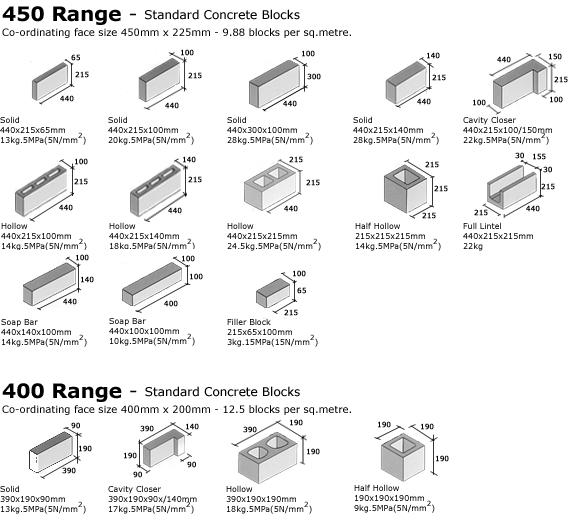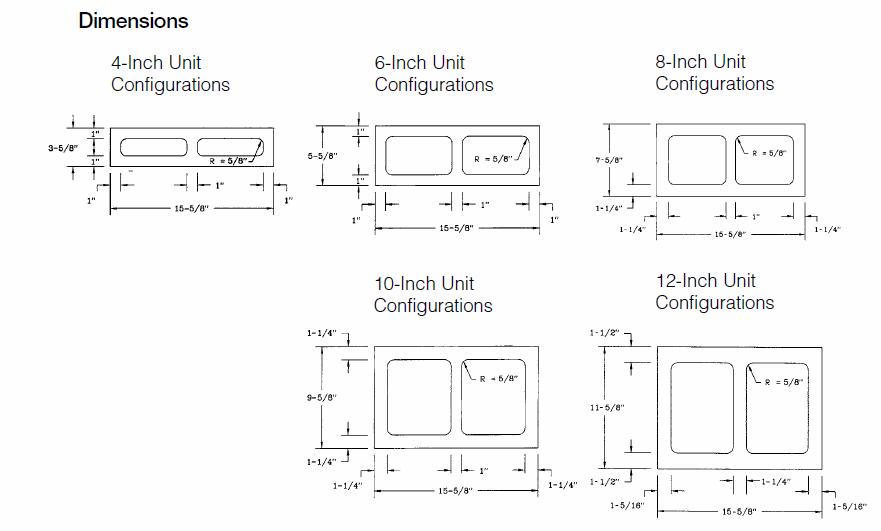Concrete Masonry Units (CMUs), also referred to as concrete block as well as cinder block, play significant roles in contemporary construction since it has structural strength, resistance to fire, and modularity. Whether an architect is designing a load bay wall, a fire-rated wall, or providing a decorative skin, CMU dimensional considerations are paramount in making their design both efficient and allowing the proper selection of materials.
In this guide, you will learn all about the CMU block dimensions, including the most frequently used concrete block sizes, special shapes, and finishes. Available in several widths, heights, and finishes, the use of the correct CMU block can affect the speed of your construction, the cost, and the architectural design of your building.
Standard CMU Dimensions
When discussing CMU dimensions, make a distinction between nominal and actual dimensions. The nominal sizes incorporate mortar joint (3/8″), whereas actual measurements are the precise measurements of the block size itself.

A. Common Nominal Sizes:
- 8x8x16 CMU dimensions (most standard size)
- 4″ CMU dimensions: Used for partitions or veneers
- 6 CMU dimensions: Mid-weight walls or smaller load applications
- 12″ CMU dimensions: Heavier-duty, load-bearing walls
These blocks are generally named by their width, height, and length, such as:
- 8” x 8” x 16”
- 6” x 8” x 16”
- 4” x 8” x 16”
- 12” x 8” x 16”
B. Actual CMU Block Dimensions in Inches:
| Nominal Size (inches) | Actual Size (inches) |
| 8″ x 8″ x 16″ | 7 5/8″ x 7 5/8″ x 15 5/8″ |
| 6″ x 8″ x 16″ | 5 5/8″ x 7 5/8″ x 15 5/8″ |
| 4″ x 8″ x 16″ | 3 5/8″ x 7 5/8″ x 15 5/8″ |
| 12″ x 8″ x 16″ | 11 5/8″ x 7 5/8″ x 15 5/8″ |
These CMU dimensions in inches are essential for accurate material take-offs and coordination with structural or architectural plans.
C. Downloadable Reference: CMU Dimensions Chart
A printable CMU dimensions chart, which displays both nominal and actual block sizes and dimensions of varying types and thicknesses, is useful in quickly accessing information while on the job site or in the process of reviewing designs.
Special CMU Shapes and Profiles
Beyond rectangular blocks, the masonry industry has many sizes and shapes of CMU blocks to fit the requirements of the construction scale. The shapes enhance functionality, increase installation rates, and give flexibility to architecture.
A. Common CMU Block Shapes:
- Stretcher Block: The most common concrete block, used in mid-wall positions
- Corner Block: Designed for wall corners with smooth outer edges
- End Block (Single Open End): Used at wall ends or openings
- Partition Block: Used for thinner, non-load-bearing walls
B. Specialty Concrete Block Shapes:
- Bond Beam Block: U-shaped units used for horizontal reinforcement
- Lintel Block: Similar to bond beam but designed for use over openings
- Bullnose Block: Rounded edges for aesthetics or safety
- Split-Face Block: Textured face for decorative applications
The special block types tend to use the same concrete block dimensions as that of the normal blocks and can thus be incorporated easily. To give an example, an 8″ CMU block dimension bond beam block will align to a standard 8x8x16 block in size.
CMU Finishes: Functional and Decorative Options
In the case of architectural constructions, there is also a type of CMU block size offered by certain manufacturers, curved or chamfered, even slotted to satisfy any work of creativity or performance. These may not adhere to any official sizes of concrete block but are made to slide in the modular system of the past CMU construction.

A. Common CMU Finish Types:
- Split-Face Finish: It is a rough and rough surface in which the block is mechanically split to obtain the appearance of a natural stone. Split-face finish is widely applied in schools, commercial buildings, and decorative walls.
- Ground-Face Finish: CMU blocks of this type are ground and polished to give a smooth, uniform texture. They have become common in contemporary interiors and architectural works and where a high degree of refinement is required.
- Scored or Ribbed CMU: The grooves (vertical or horizontal) are scribed into the surfaces of these forms of concrete blocks to give the appearance of smaller masonry units or to provide shadows.
- Glazed CMU: Glazed blocks come with a shiny coating that makes them cleanable and stain-resistant- perfect in a healthcare setting, school, and laboratory.
- Painted or Coated CMU: These are standard blocks that have been painted or treated with breathable coatings to make them resistant to moisture as well as providing color.
B. Finish Impact on CMU Dimensions
Although finishes often do not appear to affect CMU block sizes, certain textures (such as split-face or ground-face) can cause small variations in the depth or surface tolerance of the block. Where cladding is to be coordinated, with control joints or with insulation layers, refer to a CMU dimensions chart at all times.
How CMU Size and Shape Affect Design
Selecting the proper sizes and shapes of CMU blocks is not purely aesthetic but rather directly influences the cost of the construction, the layout of its reinforcements, and the thermal behavior.
A. Structural Efficiency
Densely reinforced blocks, such as the 12″ CMU dimensions, offer increased load-bearing capabilities and can be seen in many foundation walls or retaining walls, and were regularly used as high-security enclosures. On the contrary, the 4″ CMU dimensions are appropriate in situations where load is not a problem, e.g., partition walls.
When using seismic or reinforced walls, blocks with a cavity to use grouting or coordination with the vertical/horizontal rebar will be necessary. As an example, 8″ CMU block dimensions permit the reinforcement on a 16” to 32” C to C basis that provides a reasonable compromise between structure and cost.
B. Thermal and Acoustic Performance
Heavier blocks like the 12″ CMU and 6 CMU dimensions offer more mass, improving both sound dampening and temperature regulation. Adding insulation in cavities or on the block face (especially in colder climates) is often required to meet energy codes.
C. Aesthetic and Layout Coordination
Using standardized 8x8x16 CMU dimensions ensures consistent module sizing throughout your design. This simplifies architectural rhythm, bond patterns, and alignment with openings like windows and doors. Varying shapes or finishes can be strategically placed to create visual interest without complicating structural layout.

CMU Specification Tips for Architects and Engineers
To maximize the benefits of concrete masonry, architects and specifiers must carefully consider both performance and design goals when choosing CMU block sizes and finishes.
A. Match Application to Size and Reinforcement
- 4″ CMU dimensions: Use for veneer, architectural cladding, or non-structural partitions.
- 6 CMU dimensions: Ideal for fire-rated partitions or medium-duty load walls.
- 8″ CMU block dimensions: The industry standard for general construction and most versatile in terms of structure and finish.
- 12″ CMU dimensions: Best for high-load walls, retaining structures, or vault-like rooms.
B. Verify Actual CMU Dimensions in Inches
While most design documents use nominal sizes, it’s critical to specify CMU dimensions in inches (actual size) when laying out openings, reinforcement, and insulation layers. Refer to a CMU dimensions chart for accuracy during planning and shop drawing reviews.
C. Coordinate with Local Suppliers
Concrete block dimensions can vary slightly between manufacturers. Always confirm local product availability and tolerances to ensure smooth procurement and compliance with project specifications.
Conclusion
Understanding CMU dimensions is fundamental for designing and building efficient, durable, and cost-effective masonry structures. When selecting CMU block sizes, it’s not just about width or weight—factors like reinforcement, insulation, finishes, and labor cost must be considered.
At Strand-Co (490 Wheeler Rd, Suite 108, Hauppauge, NY 11788), we help architects, contractors, and homeowners choose the best CMU blocks for their projects—whether it’s a public school in Suffolk County, a structural wall for a commercial building, or a decorative garden wall for a Long Island home. By selecting the right CMU block dimensions from the start, you can avoid costly mistakes and keep your project running smoothly from design to completion. Call Us Now (631) 805-3179
FAQs
1. What is the standard size of a CMU?
A typical nominal size of a CMU (Concrete Masonry Unit) is 8 inches high, 8 inches deep, and 16 inches long ( 8 x 8 x 16) to include the mortar joint. This size is very common in structural and architectural wall systems.
2. What is the actual size of an 8x8x16 CMU?
An 8x8x16 CMU is actually 7 5/8″ x 7 5/8″ x 15 5/8″. The difference provides enough room to have a 3/8″ mortar joint so that modules fit even measurements in construction.
3. What is the actual thickness of an 8 CMU wall?
There is a 7 5/8 inches actual thickness on an 8 CMU wall. This is the actual thickness of the block without considering the finishing or putting a coating on the surface.
4. What is the normal size of a standard block?
A typical (or commonly used) size of a standard concrete block nominal size is 8 x 8 x 16, using the dimensions of the block. Nevertheless, true dimensions are reduced a bit so as to allow cracks of mortar and aligned modularity blocks in masonry bricks.





